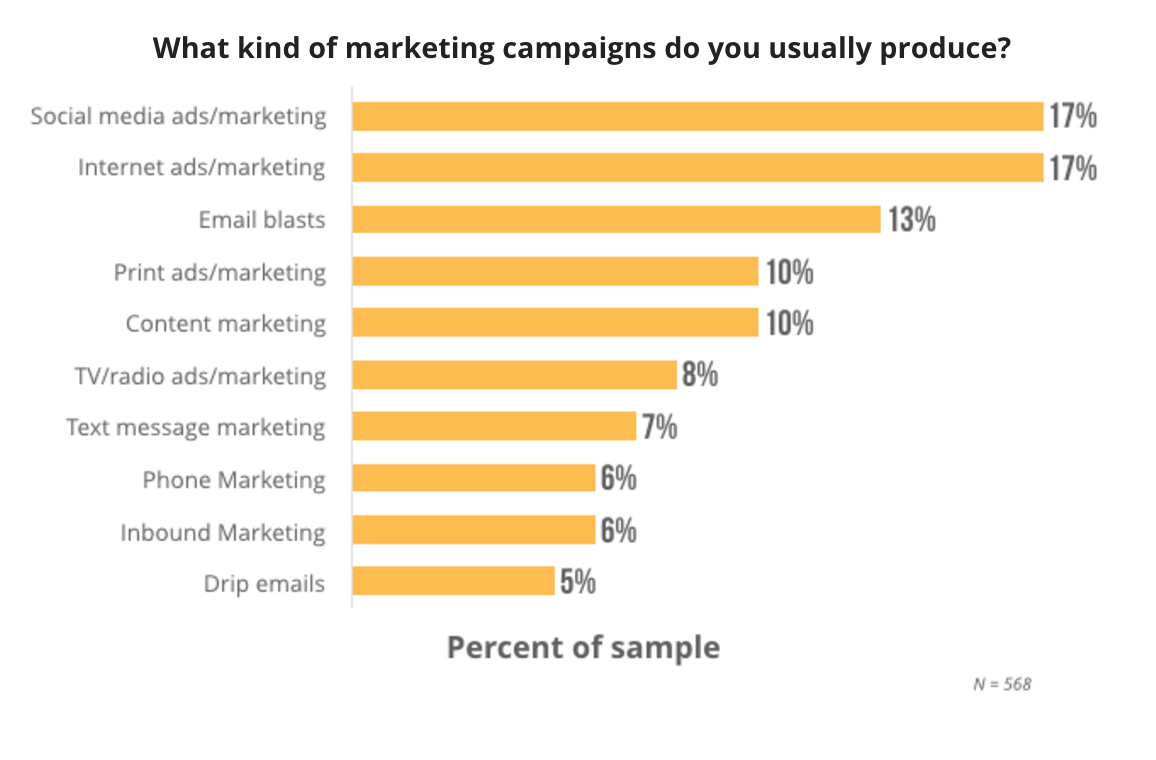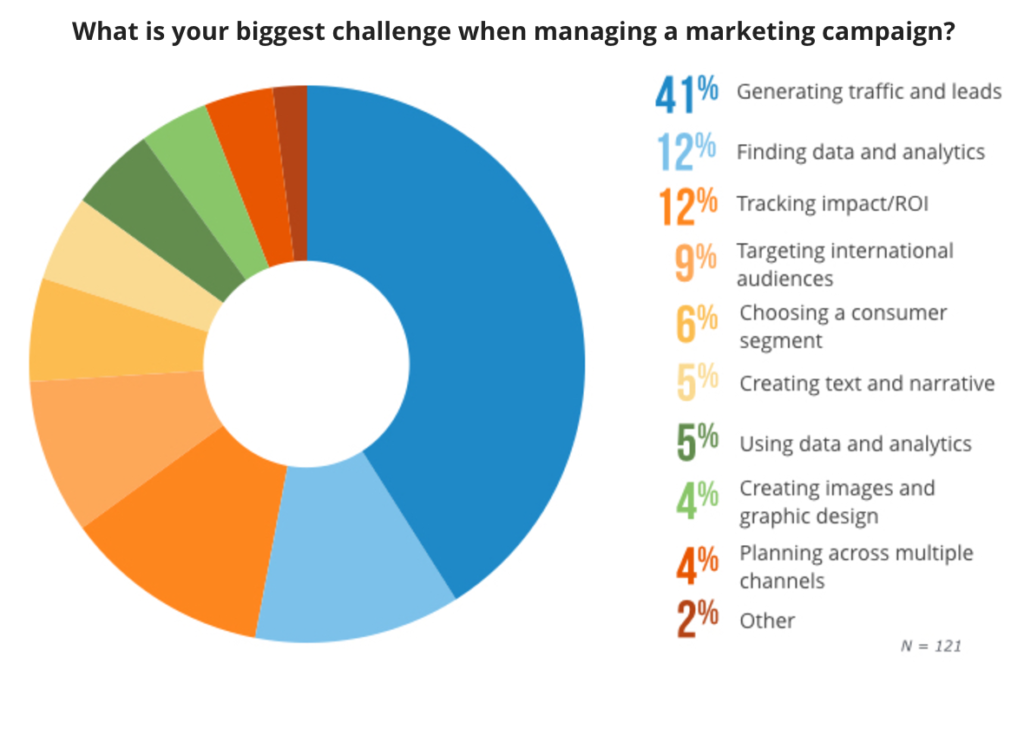Software Advice, an online reviews firm, surveyed 125 marketers to find out what results they get from their campaigns.
The survey found that almost 70% of campaigns are web-based. This is not surprising. The three most popular types of campaigns are social media ads, internet ads, and email blasts.
What is somewhat surprising is that inbound marketing and drip marketing were the two least popular campaigns. This may be partly because both are thought to be more of a series of ongoing efforts than an identifiable campaign such as “July Email Blast.”

The lack of popularity of the bottom two may be contributing to the fact that only 30% of the same marketers surveyed were “very satisfied” with their marketing campaigns’ impact on their business.
In this post, we’ll look at the most significant challenges expressed by marketers as indicated by the survey results. We’ll suggest some specific ways to address these challenges. We’ll conclude with how to arrive at The Marketer’s Money Metric.
Marketing Challenge #1: Generating traffic and leads
Despite the popularity of paid search, the survey results indicate that the biggest problem for surveyed marketers is generating traffic and leads.

An approach to generating more traffic and leads
Many companies try to increase traffic and leads by taking on one or two of the following in isolation:
- Hire a paid search agency
- Hire an SEO expert to optimize existing content
- Build new backlinks
- Start a blog
- Create landing pages
- Record and post videos
- Host a series of webinars
- Add a chat window to the website
- Implement a call-tracking solution
- Invest in campaign management software
Some companies can live on paid search alone, especially if it’s done really well. But, for most companies, none of the above items will work well in isolation. Increasing traffic and leads is a multi-pronged effort.
Determining the best set of tactics and implementing them in the correct sequence starts by asking high-level questions. Here are examples.
- What are our top marketing objectives?
- What are our best target markets?
- Who are our buyers within target companies?
- What types of information are those buyers seeking?
- What are our competitors doing?
- Which internal and external digital marketing resources will be responsible for what tasks?
Answers to these questions need to come not just from marketing but also from sales. Getting input from senior management is always a plus, but is not always possible.
The approaches that the answers drive are best articulated and memorialized in one or more digital marketing campaign playbooks. Usually, a campaign playbook is specific to a product or a service offering.
Marketing Challenge #2: Finding data and analytics
The Software Advice survey found that the second biggest challenge for marketers, after generating traffic and leads, is finding data and analytics.

An approach to finding data and analytics
One reason that finding data analytics challenges many marketers is that data lives in multiple silos. These silos include:
- Google Analytics
- The campaign management system
- The CRM system
- The brains of salespeople
Extracting, consolidating, and comparing data from the first three is a technical exercise. Getting data from the fourth source is a human challenge. A common problem across organizations is transforming less data-oriented humans (salespeople) into those more diligent about data entry and maintenance.
Salesperson Diligence
In the ideal world, if someone received a marketing email and then called in because of that email, the salesperson receiving the lead would enter a source of “Email Campaign” with reference to the specific campaign into the Lead that they create in CRM.
A side note: the salesperson should have a way to select why they disqualified a lead. This is essential analytical feedback that sales can give to marketing.
Data Flow From The Campaign Management System to CRM
The other part of solving the data analytics problem is creating the right flow of information among silos. For example, if a website visitor navigates to a “Free Report” landing page when a lead is created in CRM, the source should be “Web Form,” and the name of the web form should be auto-filled into a separate field.
In turn, a marketer needs a dashboard or spreadsheet with connections to multiple data sources. This will enable a marketer to view the full progression from visitor to landing page to lead.
The final analytical leg is the financial outcome.
Marketing Challenge #3: Tracking impact/ROI
The Software Advice survey also revealed that a big problem faced by marketers is tracing the financial impact of their campaigns.
How can we better track impact/ROI?
For impact to be fully tracked, several things need to happen.
- As mentioned above, digitally collected lead source information needs to flow into CRM
- Sales management needs to buy into the value of salespeople being more data-focused
- When lead source information can’t be automatically inserted into CRM, salespeople need to consistently ask about and enter source information into a Lead record
- CRM needs to be set up to track digital and non-digital lead sources from Lead to Opportunity to Order (if orders are being tracked in CRM)
- If possible, won CRM Opportunities or completed Orders should be updated with the actual invoice amount
- Analytics from both the campaign management system and CRM system should be available in a single view
Data Flow Within CRM
Upon Lead conversion, the source of each lead and the source type or campaign should flow through to the Opportunity in CRM. When an Opportunity is closed and the financial value is entered, the data is available for showing the return on specific marketing campaigns.
For organizations that also use Quote to Order functionality in CRM, the lead source information should flow through to the Order. In most cases, an Order amount will more closely reflect reality than an Opportunity amount.
When a marketer can access an order amount, order date, the lead source, and the type of lead source, they’ve arrived at the Marketer’s Money Metric. The marketer can now report which campaigns and other activities contributed to how much top-line revenue and when.
This completes the Awareness to Order path.
Conclusion
The marketing challenges revealed in the Software Advice survey can be addressed by a multi-pronged “people, process, technology” approach that includes campaign management software.
By getting full buy-in from sales management and salespeople and having systems configured and connected correctly, marketers can get a complete picture of the effectiveness of their marketing activities.




